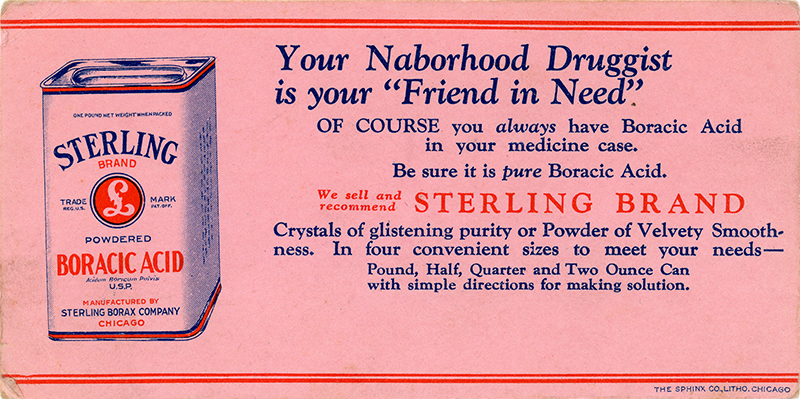Sterling Borax Advertising Ephemera: Ink Blotter
Tick Canyon

Click image to enlarge
| Download archival scan
Advertising ephemera from the Sterling Borax Co. in Tick Canyon: an ink blotter, heavy pink stock (the common standard), 6x3 inches, circa 1910s. One sided. "Your Naborhood Druggist is your Friend in Need." Boracic acid comes in crystals of glistening purity or powder of velvety smoothness. A write-up on ink blotters in the Graphic Arts Collection at Princeton University Library explains:
Many years ago, when writing was done with a pen and liquid ink, soft sheets of unsized paper were used to blot the excess ink from the page. During the nineteenth century, the ubiquitous blotter packet was quickly recognized as an advertising opportunity for local companies. Michael Twyman writes: "The advertising blotter, effectively a desk-top trade card and year-round promotion piece, remained in general use until the advent of the ball point pen, which in the period 1945 to 1960 progressively replaced the steel rib and liquid inks" (Encyclopedia of Ephemera, 2000). Early blotting paper was grey and coarse, but during the nineteenth century, a higher quality paper was used in a variety of colors. Pink was most common due to the use of turkey and cotton rags, which resisted bleaching. Queen Victoria is said to have used a red blotting paper, but we don't know for sure because each sheet was carefully destroyed.
About Sterling Borax. Sterling Borax was incorporated (we now know) on May 8, 1908, in Nevada. Headed by Thomas Thorkildsen and Stephen Tyng Mather (later creator of the National Park Service and its first director), Sterling Borax was a consolidation of the Thorkildsen-Mather Borax Co. of Chicago (workings in California); the American Borax Co. (workings at Daggett, Calif.) and its subsidiary Brighton Chemical Co. of New Brighton, Pa.; and Stauffer Chemical Co. of San Francisco and its Frazier Borate Co. (aka Frazier Borax Co.). Sterling Borax's principal works as of 1908 were at Lang (Tick Canyon) in the Santa Clarita Valley and the American Borax Co.'s operation off of the Tonopah & Tidewater Railroad near Daggett, east of Barstow. With an issuance of $1 million in capital stock, Sterling Borax Co. was formed as a rival to Francis "Borax" Smith's Pacific Coast Borax Co., which had been gobbling up borax mining start-ups across Death Valley. Thorkildsen and Mather worked together at PCB in Chicago for several years and developed significant disagreements with Smith during that time. Thorkildsen left for California in 1898 and used his life savings of $17,000 to buy a claim on Frazier Mountain in Ventura County. That same year he and Mather formed their own borax company (Thorkildsen-Mather), even while Mather stayed on at PCB. Mather finally left PCB in 1904 and joined Thorkildsen in 1905 at Frazier Mountain. Just as that borate deposit was playing out, a new opportunity presented itself. In the spring of 1905, two gold prospectors, Louis Ebbenger and Henry Shepard, discovered a rich deposit of colemanite (a borate) in Tick Canyon. They lacked the resources to mine and process the mineral themselves, so they sold their claim to Thorkildsen-Mather for $80,000. By some accounts, Thorkildsen and Mather started using the Sterling Borax name at that time; others say the company was founded Jan. 15, 1908. Since we now know the joint venture incorporated May 8, 1908, it's likely the various interests executed their merger agreement January 1908 and decided to use the preexisting company name. Three years later (1911), Francis "Borax" Smith's Pacific Coast Borax Co. bought out Sterling Borax for $1.8 million and agreed to keep Thorkildsen and Mather on payroll for 10 years. Sterling Borax then operated as a separate PCB subsidiary with Thorkildsen as president and Mather as vice president until 1921, when the 10 years were up. Why incorporate in Nevada? We don't know. Maybe they planned to compete with Smith in Nevada. Or maybe Nevada was simply an easier and cheaper place to incorporate, as Delaware would become.
LW3632: 9600 dpi jpeg from original item purchased 2019 by Leon Worden.
|
